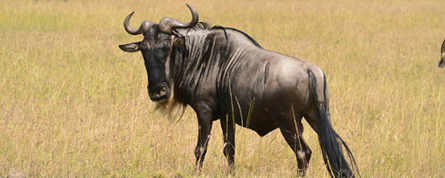

 Day 1 | ||||||||||||||||||||||||
 | ||||||||||||||||||||||||
| ||||||||||||||||||||||||
|
| ||||||||||||||||||||||||
Arusha - Lake ManyaraAfter breakfast, departure from Arusha towards Lake Manyara National Park. From Arusha it takes about 2 hours (110km) to reach the entrance to Lake Manyara National Park. Check-in to the park takes place from the small rural town of Mto-wa-Mbu (the name means "mosquito river"), which is surrounded by a fertile agricultural district with large orchards. Lake Manyara is located along Great Rift Valley, formed 20 million years ago, which extends 6400 km from the Dead Sea to the Kalahari Desert in Botswana. The park is very beautiful with wooded hilly terrain along the Great Rift Valley and houses expansive beach meadows facing the bird lake attraction. No less than about 400 bird species have been observed and sometimes the lake is invaded by thousands of pink shimmering smaller flamingos. | ||||||||||||||||||||||||
Day 2 | ||||||||||||||||||||||||
 | ||||||||||||||||||||||||
| ||||||||||||||||||||||||
Lake EyasiThe town of Karatu is about a 2-hour drive (approximately 50 km) from Lake Eyasi. This is a soda lake with an area of about 1000 km². The lake is located southwest of the Ngorongororeserve in the area of the Great Rift Valley. Depending on the time of year and precipitation, the lake's water surface varies during the year. The area does not offer game viewing, but hippos can sometimes be observed. Flamingo and Pelikan observations occur periodically. The main purpose of a visit to Lake Eyasi is to get an insight into how the tribal people Hadzabe and Datoga live. The people's group Hadzabe, which there are about 800 individuals left of, is popularly called "Bushmen". Hadzabe is a nomadic people who live in the traditional way as hunters and collectors, which they have done for about 10 000 years. Small game hunting, jewellery production and the collection of wild honey are occupations that make up their everyday lives. The tribal people Datoga originates from Ethiopia, but has resided in Tanzania for about 350 years. Like Hadzabe, they have managed to keep most of their ancestral traditions. Datoga is resident and has cattle, especially goats and cows, but they also devote themselves to small-scale agriculture and barter trade. | ||||||||||||||||||||||||
 Day 3 | ||||||||||||||||||||||||
 | ||||||||||||||||||||||||
| ||||||||||||||||||||||||
|
| ||||||||||||||||||||||||
Tarangire National ParkArea: 2850 km² Tarangire National Park is located 50 km south of Lake Manyara National Park. The nature is varied in Tarangire with palm forest, tree and grassy savannas, cliffs and hilly terrain. The park is known for its characteristic baobab trees which grow up to 15 meters high. Without the existence of the Tarangire River, this park would not house much wildlife. The park is one of the most abundant national parks in Tanzania for birds (in terms of number of species). Tarangire is the elephant densest national park in Africa with about 2,000 elephants during September – December. During the months of January - March, zebras and wildbeest give birth to their calves annually. | ||||||||||||||||||||||||
Day 4 | ||||||||||||||||||||||||
 | ||||||||||||||||||||||||
| ||||||||||||||||||||||||
|
| ||||||||||||||||||||||||
Tarangire - ArushaMorning safari and then return to Arusha (120km - 1.5 hours) for overnight stay. If the trip ends at Kilimanjaro International Airport, the journey takes about 3 hours (170km) from Tarangire. |